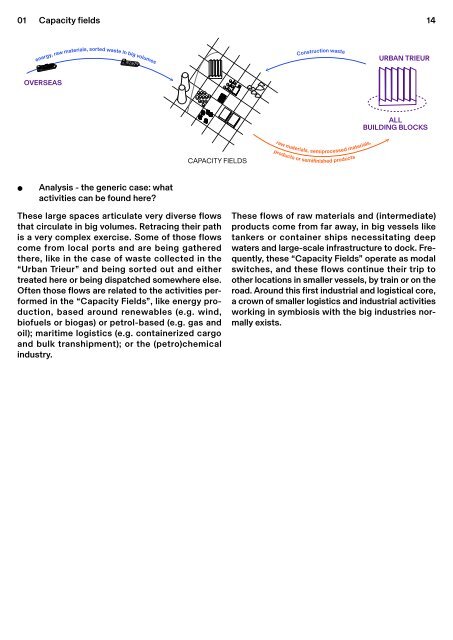Circular (City) Ports_Workbook 2_ Buildings Blocks
Create successful ePaper yourself
Turn your PDF publications into a flip-book with our unique Google optimized e-Paper software.
01 Capacity fields<br />
14<br />
energy, raw materials, sorted waste in big volumes<br />
Construction waste<br />
URBAN TRIEUR<br />
OVERSEAS<br />
ALL<br />
BUILDING BLOCKS<br />
raw materials, semiprocessed materials,<br />
CAPACITY FIELDS<br />
products or semifinished products<br />
●<br />
Analysis - the generic case: what<br />
activities can be found here?<br />
These large spaces articulate very diverse flows<br />
that circulate in big volumes. Retracing their path<br />
is a very complex exercise. Some of those flows<br />
come from local ports and are being gathered<br />
there, like in the case of waste collected in the<br />
“Urban Trieur” and being sorted out and either<br />
treated here or being dispatched somewhere else.<br />
Often those flows are related to the activities performed<br />
in the “Capacity Fields”, like energy production,<br />
based around renewables (e.g. wind,<br />
biofuels or biogas) or petrol-based (e.g. gas and<br />
oil); maritime logistics (e.g. containerized cargo<br />
and bulk transhipment); or the (petro)chemical<br />
industry.<br />
These flows of raw materials and (intermediate)<br />
products come from far away, in big vessels like<br />
tankers or container ships necessitating deep<br />
waters and large-scale infrastructure to dock. Frequently,<br />
these “Capacity Fields” operate as modal<br />
switches, and these flows continue their trip to<br />
other locations in smaller vessels, by train or on the<br />
road. Around this first industrial and logistical core,<br />
a crown of smaller logistics and industrial activities<br />
working in symbiosis with the big industries normally<br />
exists.


















